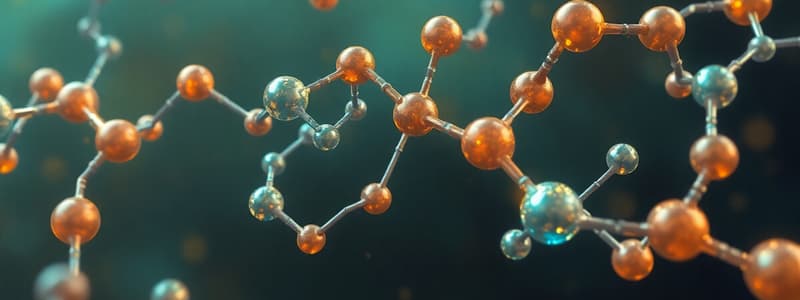Podcast
Questions and Answers
What structural components are present in glycine?
What structural components are present in glycine?
- Hydroxyl group and an aldehyde group.
- Amine group and a ketone group.
- Amine group and a carboxylic acid group. (correct)
- Thiol group and a carboxylic acid group.
Deprotonation of the carboxylic acid group in glycine results in the formation of a carboxylate anion.
Deprotonation of the carboxylic acid group in glycine results in the formation of a carboxylate anion.
True (A)
What term describes a Lewis acid center interacting with one or more bases?
What term describes a Lewis acid center interacting with one or more bases?
Complex
The glycinate anion interacts with the copper ion using both a nitrogen and an oxygen center, which is referred to as a ' ______ ' complex.
The glycinate anion interacts with the copper ion using both a nitrogen and an oxygen center, which is referred to as a ' ______ ' complex.
Match the configuration of ligands around the copper center with its description:
Match the configuration of ligands around the copper center with its description:
In the synthesis of bis(glycinato)copper(II) monohydrate isomers, which isomer is thermodynamically more stable?
In the synthesis of bis(glycinato)copper(II) monohydrate isomers, which isomer is thermodynamically more stable?
The preparation of cis-bis(glycinato)copper(II) monohydrate requires high temperatures to facilitate the reaction.
The preparation of cis-bis(glycinato)copper(II) monohydrate requires high temperatures to facilitate the reaction.
What is the purpose of refluxing a reaction solvent?
What is the purpose of refluxing a reaction solvent?
Why are boiling chips added to a reaction?
Why are boiling chips added to a reaction?
A variac, or variable transformer, is a piece of equipment that can vary the ______ supplied to its outlet.
A variac, or variable transformer, is a piece of equipment that can vary the ______ supplied to its outlet.
Flashcards
Glycine
Glycine
Building blocks of proteins, including an amine group and a carboxylic acid.
Complex
Complex
The term for a Lewis acid center interacting with one or more bases (ligands).
Chelate complex
Chelate complex
A complex where a glycinate anion interacts with the copper ion using nitrogen and oxygen.
Reflux
Reflux
Signup and view all the flashcards
Boiling chips
Boiling chips
Signup and view all the flashcards
Variac (Variable Transformer)
Variac (Variable Transformer)
Signup and view all the flashcards
Study Notes
- Glycine is one of 20 amino acid building blocks of proteins.
- Glycine's structure has an amine group at one end and a carboxylic acid at the other.
- Deprotonation of the acid produces a carboxylate anion, which is the conjugate base of glycine.
- The glycinate anion behaves as a Lewis base and interacts with Lewis acids, including metal centers, forming complexes.
- A "complex" refers to a Lewis acid center interacting with one or more bases, known as "ligands."
- Menkes disease, a rare neurological disorder, is treated with a copper amino acid complex.
- The glycinate anion interacts with the copper ion via a nitrogen and an oxygen center, forming a "chelate" complex.
- The term "chelate" comes from 'claw."
- The geometry of the copper center in chelate complexes is square planar.
- Ligands in these complexes can interact with the two oxygen atoms on the same side (cis configuration) or opposite sides (trans configuration).
- This configurational distinction allows for the formation of two geometric isomers.
- Isomers of bis(glycinato)copper(II) as monohydrate will be synthesized.
- The less thermodynamically stable cis isomer (kinetically stable) transforms into the thermodynamically stable trans isomer using heat (energy).
- Cis-bis(glycinato)copper(II) monohydrate is prepared at relatively low temperatures.
- Trans-bis(glycinato)copper(II) monohydrate preparation requires heat to promote the reactions.
- The reaction solvent, water, will be boiled at reflux.
- Reaction rates generally increase with temperature.
- If the reaction temperature reaches the solvent's boiling point, the solvent evaporates.
- Reflux involves cooling the evaporated solvent with a condenser above the reaction, causing it to drain back into the reaction vessel, preventing solvent loss.
- Boiling chips provide a high surface area for evaporating solvent to form bubbles.
- Without boiling chips, rapid bubble formation can cause the reaction solution to erupt violently.
- A magnetic stirrer is another method to prevent violent eruption from rapid bubbles.
- When working with multiple interconnected glassware pieces, clamp only one piece securely.
- Clamping more than one piece can strain and break the glassware.
- A variac (variable transformer) adjusts the voltage supplied to its outlet.
- Dial marks on the variac indicate the voltage percentage supplied to the outlet.
- Heating mantles behave differently at a given voltage, requiring voltage adjustments to achieve the proper heat.
Studying That Suits You
Use AI to generate personalized quizzes and flashcards to suit your learning preferences.
Related Documents
Description
Explore glycine's role as an amino acid building block and its ability to form complexes. Learn how the glycinate anion acts as a Lewis base, interacting with metal centers like copper to form chelate complexes. Understand the significance of cis and trans configurations in these complexes.



